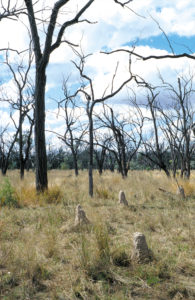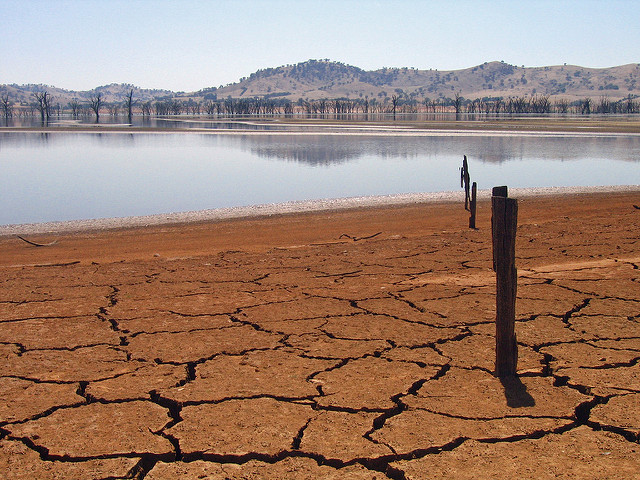In southern New South Wales, the Darling River started flowing in September for the first time in a year, and the Lachlan River hit heights not seen for decades.
Meanwhile, it’s getting humid in the far north of Australia, and there’s a strong chance that the first rains of the tropical wet season will arrive earlier than usual.
The forecast is looking good for dams and reservoirs.
Australia has one of the most variable climates in the world. Irregular rainfall and high rates of evaporation mean that reliable river flows are limited and Australia has “the smallest volumes of run-off of all the inhabited continents”, according to the report, Building resilience to drought: The Millennium Drought and water reform in Australia, recently published by the Australian Water Partnership.
As a result, the report says, “Australia depends on its water storage more than other developed countries do, and stores more water per head of population than anywhere else in the world.”
All this makes it is the toughest continent on Earth to road test a system that aims to predict water availability—but also the most in need.
A history of drought
The continent has a history of drought. The 1895–1903 drought resulted in the death of half of Australia's sheep flock and 40% of its cattle. During the 1963–68 drought, wheat production fell 40%.

The Millennium Drought, from 1997 to 2009, was the worst in 200 years.
It decimated production in Australia’s most important agricultural regions, with some sectors hit worse than others. From 2005/06 to 2006/07, cotton production dropped 80%.
It significantly affected the health of rivers, particularly in the Murray–Darling Basin where we saw toxicity in the lakes at the end of River Murray and the death, on a large scale, of floodplain forest throughout the basin.
Farmers carried an enormous personal and national burden during this period. According to the 2009 Productivity Commission Inquiry Report into Government Drought Support, in 2007–08, 23% of our 143,000 farms received drought assistance totalling more than $1 billion; some farmers had received income support continuously since 2002.
On the cusp of the 21st century, a line in the sand was drawn: Australia could no longer survive the siege mentality of drought embedded in the continent’s psyche. We needed a better way to manage conditions.
The trigger for change
The severity of the ‘Big Dry’, as the Millennium Drought was also known, triggered a comprehensive response by the Australian Government to reform water management—long-horizon in scope, ambitious in scale and transformative in nature. It might have been called courageous.
On paper, one of the changes seems like a bureaucratic piece of regulation, but the federal government Water Act 2007 has revolutionised the way we think about water, simply by empowering good decision-making through knowledge.
The Act granted the Director of the Australian Bureau of Meteorology the power to issue national standards for water information, and to collate, analyse and disseminate water information as a foundation for more efficient water use and sharing of Australia’s river and groundwater systems.

WIRADA brings national, reliable water information
The Bureau of Meteorology and CSIRO subsequently formed a critical partnership in 2008, the Water Information Research and Development Alliance—WIRADA.
Using complex science, millions of water and climate measurements for catchments across the continent, and a range of new analysis methods, WIRADA has produced publicly available river flow forecasts and water information.
Where once more than 200 different organisations around the country collected information about water availability from rivers, streams, dams, lakes and reservoirs, Australia now has national, reliable water information covering:
- streamflow forecasts that regional water managers use for decisions about scheduling and allocating water
- data transfer formats that are now embedded in water industry software and used by water agencies to exchange water information
- landscape water balance models that underpin national water accounting
- on-going regional water availability assessments
- a digital elevation model for the continent and improved rainfall and evapotranspiration estimates.
Eight years and $65 million in the making, this work has involved more than 200 scientists working across 27 research projects.
Empowering water managers and farmers
Warwick McDonald, Research Director and inaugural Director of WIRADA: “From a water manager’s perspective,
“The Bureau is now providing a series of publicly available products and services that forecast the availability of water in rivers for 0–7 days for the short term, to support flood forecasting, right through to a seasonal outlook for stream flows into our major dams so that allocations can be made by the water authorities.”
The 7-day streamflow forecasts mean that, when natural flows are expected, water managers can release less water in irrigation systems. They are also better informed in meeting the high and low flow needs of rivers and wetlands. Reservoir operators are also better informed and farmers can make more informed water management decisions.
The seasonal streamflow forecasts can influence important decisions about water allocations, cropping strategies, water market planning, environmental watering, operation of multi-storage water supply schemes, and water supply restriction during drought.
With more than 100 international science journal papers published based on the work, some in prestigious hydrology journals Water Resources Research and the Journal of Hydrology, Mr McDonald adds that the publication record alone shows CSIRO’s contribution to the underpinning science that made the Bureau’s information products and services possible.
A paradigm shift in water management
The accuracy of the forecasts was improved by up to 30%, thanks to a significant advance in developing statistical methods to correct biases in precipitation forecasts from weather and climate models.
Professor George Kuczera from the University of Newcastle, who specialises in the use of Bayesian statistical methods in hydrological applications, says the research has created a “paradigm shift in Australian water management”.
He describes the technical challenges of this work as “formidable” and the research outcomes as “impressive, not only in their originality but also in their elegance”.
Dr Rob Vertessy, recently retired as CEO of the Bureau of Meteorology, says the research is a breakthrough for Australia and the world.
“Very creative thinking has been applied to a very common problem: How much water will flow in our rivers in the days, weeks and months ahead?” he said.
“The project has delivered very novel solutions to a long-standing problem that no-one had previously cracked. In this regard, it is best classified as a substantial advance—or rather a massive breakthrough—in understanding a current problem.”
Taking our water forecasting expertise to the world
CSIRO researchers and Bureau staff are also helping other countries establish their own water forecasting systems, with almost 50 research collaborators.
In the US, the National Oceanic and Atmospheric Administration’s Climate Prediction Centre has won a nationally competitive grant to collaborate with the Australian team to evaluate its methods for operational forecasting of seasonal climate there. CSIRO’s Dr QJ Wang and Andrew Schepen are principal researchers on this work. Dr Wang is also co-chair of HEPEX, a major international initiative in hydrology.
Operations team leader from the Bureau of Meteorology Dr Narendra Tutja leads contributions to the World Meteorological Organization guidelines for water forecasting, which draw on the Australian example of operation water forecasting.
Dr Vazken Andréassian, Deputy Scientific Director of Hydrology and Hydraulics at the French National Research Institute of Science and Technology for Environment and Agriculture, says the forecasting methods are “truly remarkable, and effectively unique in the world”.
“Of course, the forecasting models will not make rain fall,” he adds. “But, at last, Australia will be able to face the future challenges of water management in a changing climate.”
